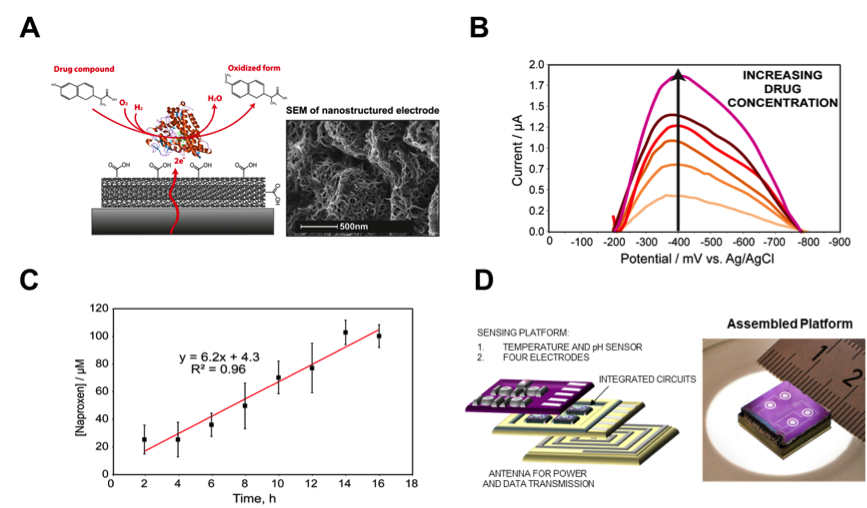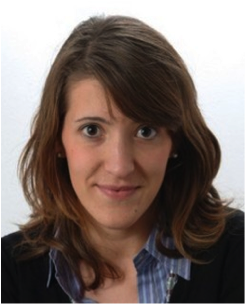Go to
Camilla Baj-Rossi
Electrochemical platform based on cytochrome P450 for diagnostic applications in personalized medicine
The personalization of drug therapies has a significant effect on quality and cost of healthcare. In order to personalize a pharmacological treatment, it is required to monitor the concentration of drugs or their metabolites directly in blood and then extract some important pharmacokinetic parameters1. Amperometric biosensors provide rapid, accurate and quantitative detection of drugs and metabolites with an inexpensive and simple to use set-up. A promising approach is based on cytochrome P450 enzymes2 (CYP). Cytochrome P450 enzymes possess multiple substrate recognition sites; therefore they are able to metabolize a wide range of drugs.

Figure 1. A) Proposed reaction scheme of the electron transfer to cytochrome P450 and the electrocatalysis of the drug; B) Cyclic voltammetry of Cytochrome P4501A2 in presence of increasing concentration of an anti-inflammatory drug; C) In vitro monitoring of Naproxen (anti-inflammatory drug) continuously delivered by an osmotic pump for 16 hours; D) Schematic and picture of the integration of an implantable platform for multiple drug monitoring.
The aim of the project is the realization of an integrated biochip for real-time detection of multiple drug compounds. CYP proteins and cyclic voltammetry are employed to identify and quantify the drugs in the sample (Fig. 1B). The detection mechanism of CYP-biosensors is based on the quantification of the drug concentration present in the sample through the coupling of the binding reaction between the CYP and the drug to a current signal, which is detectable with an electrode3 (the detection mechanism for CYP-based biosensors is schematized in Fig. 1A). Multi-walled carbon-nanotubes are used for nano-structuring the electrodes in order to decrease the detection limit until the pharmacological ranges of the considered drug compounds. The sensing platform will be employed to monitor drug in real-time (Fig. 1C), and to detect multiple drugs in human serum. The integrated chip (Fig. 1D), consists of a sensing platform made by an array of electrodes, and other two sensors used to monitor fluctuations in temperature and pH that can affect the electrochemical response of enzymes during drug biosensing. Moreover, the chip is designed to host several microchips capable to perform all the electrochemical measurements and an antenna for the remote powering of the device and the data transmission.
1 J. Lazarou, B. Pomeranz, and P. Corey, Jama, 279, 1200, 1998.
2 N. Bistolas, U. Wollenberger. C. Jung, F.W. Scheller. Biosensor and Bioelectronics 2005, 20 (12), 2408-23
3 C. Baj-Rossi, G. De Micheli and S. Carrara, Sensors, 12(5), 6520-6537, 2012.
About the speaker:
 Camilla Baj-Rossi got a Bachelor Degree in 2008 and a Master Degree in 2010 in Biomedical Engineering at Politecnico di Torino (Italy). She carried out her Master project at EPFL in the Integrated System Laboratory (LSI), working on the design of a multi-panel biochip based on P450 and CNT for drugs monitoring in personalized therapy. Currently she is a PhD student in Microsystems and Microelectronics in the Integrated System Laboratory (LSI) under the direction of Prof. Giovanni De Micheli and Dr. Sandro Carrara.
Camilla Baj-Rossi got a Bachelor Degree in 2008 and a Master Degree in 2010 in Biomedical Engineering at Politecnico di Torino (Italy). She carried out her Master project at EPFL in the Integrated System Laboratory (LSI), working on the design of a multi-panel biochip based on P450 and CNT for drugs monitoring in personalized therapy. Currently she is a PhD student in Microsystems and Microelectronics in the Integrated System Laboratory (LSI) under the direction of Prof. Giovanni De Micheli and Dr. Sandro Carrara.
Secondary navigation
- EPFL Workshop on Logic Synthesis and Emerging Technologies
- Luca Amaru
- Luca Benini
- Giovanni De Micheli
- Srini Devadas
- Antun Domic
- Rolf Drechsler
- Pierre-Emmanuel Gaillardon
- Jie-Hong Roland Jiang
- Akash Kumar
- Shahar Kvatinsky
- Yusuf Leblebici
- Shin-ichi Minato
- Alan Mishchenko
- Vijaykrishnan Narayanan
- Ian O'Connor
- Andre Inacio Reis
- Martin Roetteler
- Julien Ryckaert
- Mathias Soeken
- Christof Teuscher
- Zhiru Zhang
- Symposium on Emerging Trends in Computing
- Layout synthesis: A golden DA topic
- EPFL Workshop on Logic Synthesis & Verification
- Luca Amaru
- Luca Benini
- Robert Brayton
- Maciej Ciesielski
- Valentina Ciriani
- Jovanka Ciric-Vujkovic
- Jason Cong
- Jordi Cortadella
- Giovanni De Micheli
- Antun Domic
- Rolf Drechsler
- Henri Fraisse
- Paolo Ienne
- Viktor Kuncak
- Enrico Macii
- Igor Markov
- Steven M. Nowick
- Tsutomu Sasao
- Alena Simalatsar
- Leon Stok
- Dirk Stroobandt
- Tiziano Villa
- Symposium on Emerging Trends in Electronics
- Raul Camposano
- Anantha Chandrakasan
- Jo De Boeck
- Gerhard Fettweis
- Steve Furber
- Philippe Magarshack
- Takayasu Sakurai
- Alberto Sangiovanni-Vincentelli
- Ken Shepard
- VENUE
- Panel on Circuits in Emerging Nanotechnologies
- Panel on Emerging Methods of Computing
- Panel on The Role of Universities in the Emerging ICT World
- Panel on Design Challenges Ahead
- Panel on Alternative Use of Silicon
- Nano-Bio Technologies for Lab-on-Chip
- Functionality-Enhanced Devices Workshop
- More Moore: Designing Ultra-Complex System-on-Chips
- Design Technologies for a New Era
- Nanotechnology for Health
- Secure Systems Design
- Surface Treatments and Biochip Sensors
- Security/Privacy of IMDs
- Nanosystem Design and Variability
- Past Events Archive
